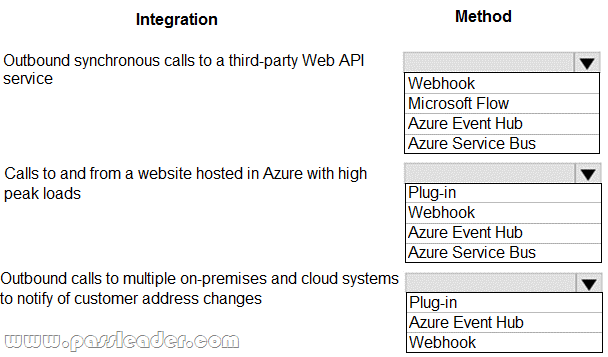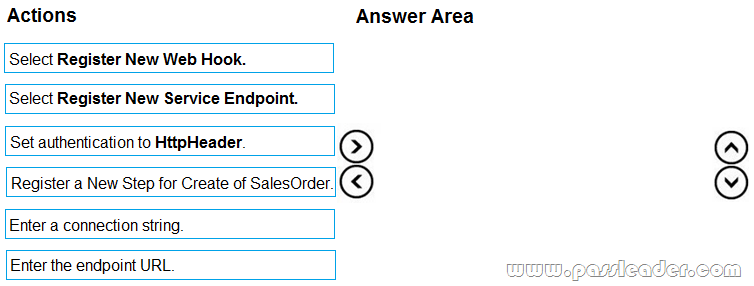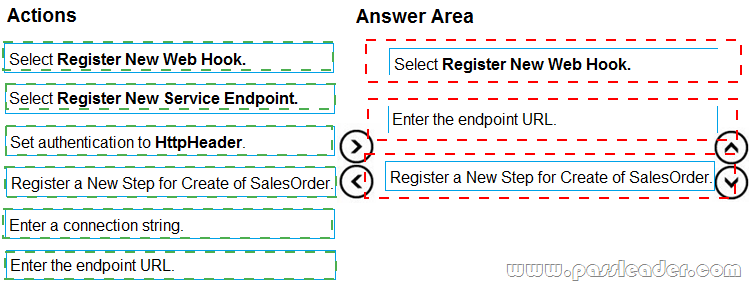Valid PL-400 Dumps shared by PassLeader for Helping Passing PL-400 Exam! PassLeader now offer the newest PL-400 VCE dumps and PL-400 PDF dumps, the PassLeader PL-400 exam questions have been updated and ANSWERS have been corrected, get the newest PassLeader PL-400 dumps with VCE and PDF here: https://www.passleader.com/pl-400.html (65 Q&As Dumps –> 115 Q&As Dumps –> 153 Q&As Dumps –> 175 Q&As Dumps –> 191 Q&As Dumps –> 272 Q&As Dumps –> 377 Q&As Dumps)
BTW, DOWNLOAD part of PassLeader PL-400 dumps from Cloud Storage: https://drive.google.com/drive/folders/19B1F9chcoivIJtnOLF0ne4f_PeafUsce
NEW QUESTION 1
A bank uses a Common Data Service solution to manage clients. Bank representatives perform client credit checks while the client is present. Credit checks may take up to five minutes to complete. Bank policy dictates that the bank representative’s app must stay blocked until credit checks are complete. You need to display a model-driven app while credit checks run to ask the bank representative and client to wait for the credit check to complete. Which function should you use?
A. Xrm.Navigation.openWebResource(“prefix.myPoliteMessage.html”)
B. Xrm.Navigation.openAlertDialog(myPoliteMessage)
C. Xrm.Utility.openWebResource(“prefix_myPoliteMessage.html”)
D. Xrm.Utility.showProgressIndicator(myPoliteMessage)
Answer: D
Explanation:
showProgressIndicator displays a progress dialog with the specified message. Any subsequent call to this method will update the displayed message in the existing progress dialog with the message specified in the latest method call. The progress dialog blocks the UI until it is closed using the closeProgressIndicator method. So, you must use this method with caution.
https://docs.microsoft.com/en-us/powerapps/developer/model-driven-apps/clientapi/reference/xrm-utility/showprogressindicator
NEW QUESTION 2
You are creating an integration that uses an Azure function to create records in the Common Data Service when leads are submitted from your company website. You create and configure a Common Data Service application user. You do not have administrator access to the Common Data Service environment you are using for access to Azure Active Directory. Company policy dictates that service accounts must be used for integrations, and integrations must not be granted privileges beyond what is needed. You need to recommend actions that an administrator should perform to configure access for the Azure Function. Which three actions should you perform? (Each correct selection presents part of the solution. Choose three.)
A. Create an application registration in Azure Active Directory.
B. Assign the system administrator security role to the application user.
C. Assign the Power Platform administrator role to the application user in Azure Active Directory.
D. Create a new security role with the minimum required permissions and assign to the application user.
E. Grant the application delegated permissions to the Dynamics CRM API in Azure Active Directory.
F. Deploy Azure B2B guest permissions to the application user.
Answer: ADE
Explanation:
https://docs.microsoft.com/en-us/powerapps/developer/common-data-service/walkthrough-register-app-azureactive-directory
NEW QUESTION 3
A company needs to illustrate the relationships of the entities in Dynamics 365 Sales. You need to select the appropriate tool to show this graphic. Which tool should you select?
A. Metadata diagram
B. Sales Insights
C. Power Automate
D. Security model
Answer: A
Explanation:
Visual representation of metadata can be useful, especially when you are trying to describe the relationship between entities in the system. You can use the Metadata Diagram sample code provided for Dynamics 365 Customer Engagement (on-premises) to generate the entity relationship diagrams. You can create a diagram that shows a relationship for just one entity, or a complex diagram that includes dozens of related entities, including custom and system entities.
https://docs.microsoft.com/en-us/dynamics365/customerengagement/on-premises/developer/use-metadata-generate-entity-diagrams
NEW QUESTION 4
You are creating a Power Apps app that retrieves customer information from Azure Active Directory when you use the app to look up a customer record. You create an Azure Function by using JSON code to retrieve the customer information. You need to make the application work. Which two actions should you perform? (Each correct answer presents part of the solution. Choose two.)
A. Create a Power Automate flow to import data.
B. Create a custom connector that uses the Azure Function API.
C. Copy your JSON code to the app.
D. Create a custom connector that uses the JSON code.
E. Create an API definition for the Azure Function.
Answer: BE
Explanation:
E: Before exporting an API, you must describe the API using an OpenAPI definition.
B: This OpenAPI definition contains information about what operations are available in an API and how the request and response data for the API should be structured. PowerApps and Microsoft Flow can create custom connectors for any OpenAPI 2.0 definition.
https://github.com/MicrosoftDocs/azure-docs/blob/master/articles/azure-functions/app-service-export-api-topowerapps-and-flow.md
NEW QUESTION 5
A company uses a model-driven app to record details of laboratory test. You are asked to create a custom component that makes it easier to capture multiple values from lab test results on mobile devices. You need to create the interface for the dataset in case the mobile devices lose connection to the network. Which method should you use?
A. SaveData
B. updateView
C. init
D. getClient
Answer: A
Explanation:
Use LoadData and SaveData for basic data storage while offline.
https://powerapps.microsoft.com/sv-se/blog/build-offline-apps-with-new-powerapps-capabilities/
NEW QUESTION 6
A company implements Dynamics 365 Sales. An email notification must be sent automatically to the sales manager when a business process completes. You need to ensure that emails are sent. What should you create on the process completed trigger?
A. a workflow
B. an action step
C. a data step
D. a Power Automate flow step
Answer: A
Explanation:
When you include a workflow that you want to trigger on Stage Exit of a stage in your business process flow, and that stage is the last stage in the flow, the designer gives the impression that the workflow will be triggered when that stage is completed.
https://docs.microsoft.com/en-us/dynamics365/customerengagement/on-premises/customize/businessprocess-flows-overview
NEW QUESTION 7
A financial services company uses the Common Data Service (CDS) to develop solutions. The company uses development and production instances. You need to move solutions from the development instance to the production instance. What are two possible ways to achieve this goal? (Each correct answer presents a complete solution. Choose two.)
A. In the development instance, make changes to the solutions that are deployed in the production instance, export the solutions as managed solutions, and import the managed solutions into the production instance.
B. In the development instance, highlight the solution you want to make changes to, select Clone a Patch, make changes, export the solution, and import the solution into the production instance.
C. Export all managed solutions from the development instance and import the solutions into the production instance.
D. In the production instance, import solutions with the same version number or higher when updating solutions.
Answer: AB
Explanation:
A: When you import a managed solution, all component changes will be brought into the environment in a published state.
B: You can apply patches to either managed or unmanaged solutions and include only changes to entities and related entity assets. Patches do not contain any non-customized system components or relationships that it dependents upon because these components already exist in the deployed-to organization. At some point in your development cycle, you can roll up all the patches into a new solution version to replace the original solution that the patches were created from.
https://docs.microsoft.com/en-us/powerapps/maker/common-data-service/import-update-export-solutions
https://docs.microsoft.com/en-us/power-platform/alm/create-patches-simplify-solution-updates
NEW QUESTION 8
You are developing an app that uses Common Data Service. You must integrate Common Data Service with a new web application. You must allow the new web application to display data from Common Data Service. You build a single-page web application using the Web API. You need to authenticate your app using OAuth. What should you use?
A. Windows Communication Foundation (WCF)
B. Cross-Origin Resource Sharing (CORS)
C. Microsoft Authentication Library (MSAL)
D. Kerberos Authentication
E. Active Directory Authentication Library (ADAL)
Answer: D
Explanation:
OAuth requires an identity provider for authentication. For Dataverse the identity provider is Azure Active Directory (AAD). To authenticate with AAD using a Microsoft work or school account, use the Azure Active Directory Authentication Libraries (ADAL).
https://docs.microsoft.com/en-us/powerapps/developer/common-data-service/authenticate-oauth
NEW QUESTION 9
You have a Common Data Service entity and a model-driven app. The model-driven app integrates with an external system. You plan to run business logic each time the model-driven app creates a record. Running business logic must not negatively affect model-driven app users. You need to implement the business logic. What should you use?
A. Synchronous plug-in registered in the PreOperation stage
B. Synchronous workflow
C. Asynchronous plug-in registered in the PostOperation stage
Answer: C
Explanation:
The asynchronous service executes long-running operations independent of the main Microsoft Dataverse core operation. This results in improved overall system performance and improved scalability.
https://docs.microsoft.com/en-us/powerapps/developer/common-data-service/asynchronous-service
NEW QUESTION 10
You are designing a one-way integration from the Common Data Service to another system. You must use an Azure Function to update the other system. The integration must send only newly created records to the other system. The solution must support scenarios where a component of the integration is unavailable for more than a few seconds to avoid data loss. You need to design the integration solution.
Solution:
– Register a service endpoint in the Common Data Service that connects to an Azure Service Bus queue.
– Register a step at the endpoint which runs asynchronously on the record’s Create message and in the portoperation stage.
– Configure the Azure Function to process records as they are added to the queue.
Does the solution meet the goal?
A. Yes
B. No
Answer: A
Explanation:
Microsoft Dataverse supports integration with Azure. For the Dataverse and Azure connection to work, there must be at least one solution in an Azure Service Bus solution account, where the solution contains one or more service endpoints. For a queue endpoint contract, a listener doesn’t have to be actively listening.
https://docs.microsoft.com/en-us/powerapps/developer/common-data-service/azure-integration
NEW QUESTION 11
You are designing a one-way integration from the Common Data Service to another system. You must use an Azure Function to update the other system. The integration must send only newly created records to the other system. The solution must support scenarios where a component of the integration is unavailable for more than a few seconds to avoid data loss. You need to design the integration solution.
Solution:
– Configure the Azure Function with a timer trigger that runs every five minutes.
– The function will query the Common Data Service and process records created in the last five minutes.
Does the solution meet the goal?
A. Yes
B. No
Answer: B
Explanation:
Instead use Azure Service Bus queue solution with asynchronous communication.
https://docs.microsoft.com/en-us/powerapps/developer/common-data-service/azure-integration
NEW QUESTION 12
You fix a bug in the code of your application, which is currently on version 10.0.2.1. You need to publish an updated version of the solution. Which version identifier should you use?
A. 10.0.3.1
B. 10.0.2.2
C. 10.1.0.2
D. 11.0.0
Answer: A
Explanation:
The version number are <major>.<minor>.<build>.<revision>. When we create patches in Dynamics 365, the system will automatically increment the build version (you can overwrite the chosen number when you create the patch). For example, if our solution starts at 1.0.0.0, we export it to become 1.0.0.1. We then create a patch, and the version of the patch is 1.0.1.1. If we export it now, it might become 1.0.1.2. In all cases, the build or version number has been incremented. Patches require the build or version number to increment, but not the major or minor version.
https://carldesouza.com/how-solution-version-numbers-work-in-the-microsoft-power-platform/
NEW QUESTION 13
You are building a custom application in Azure to process resumes for the HR department. The app must monitor submissions of resumes. You need to parse the resumes and save contact and skills information into the Common Data Service. Which mechanism should you use?
A. Power Automate
B. Common Data Service plug-in
C. Web API
D. Custom workflow activity
Answer: A
Explanation:
Improve operational efficiency with a unified view of business data by creating flows that use Dataverse (Common Data Service has been renamed to Microsoft Dataverse as of November 2020). For example, you can use Dataverse within Power Automate in these key ways: Create a flow to import data, export data, or take action (such as sending a notification) when data changes. Instead of creating an approval loop through email, create a flow that stores approval state in an entity, and then build a custom app in which users can approve or reject items.
https://docs.microsoft.com/en-us/power-automate/common-data-model-intro
NEW QUESTION 14
Hotspot
A company is building a new model-driven app. The app must integrate with a number of on-premises and cloud solutions. No VPNs are in place. You need to determine the method for each integration. Which methods should you use? (To answer, select the appropriate options in the answer area.)

NEW QUESTION 15
Drag and Drop
A company uses Dynamics 365 Sales. Sales commission must be calculated when an order is placed. You create an Azure Function to perform the calculation. The Azure Function has an HTTP trigger. You need to configure the Plug-in Registration tool to send data to the Azure Function when an order is placed. You open the Plug-in Registration tool and connect to Dynamics 365 Sales. Which three actions should you perform in sequence? (To answer, move the appropriate actions from the list of actions to the answer area and arrange them in the correct order.)

NEW QUESTION 16
……
Get the newest PassLeader PL-400 VCE dumps here: https://www.passleader.com/pl-400.html (65 Q&As Dumps –> 115 Q&As Dumps –> 153 Q&As Dumps –> 175 Q&As Dumps –> 191 Q&As Dumps –> 272 Q&As Dumps –> 377 Q&As Dumps)
And, DOWNLOAD the newest PassLeader PL-400 PDF dumps from Cloud Storage for free: https://drive.google.com/drive/folders/19B1F9chcoivIJtnOLF0ne4f_PeafUsce

